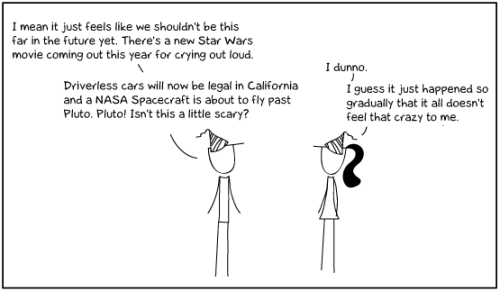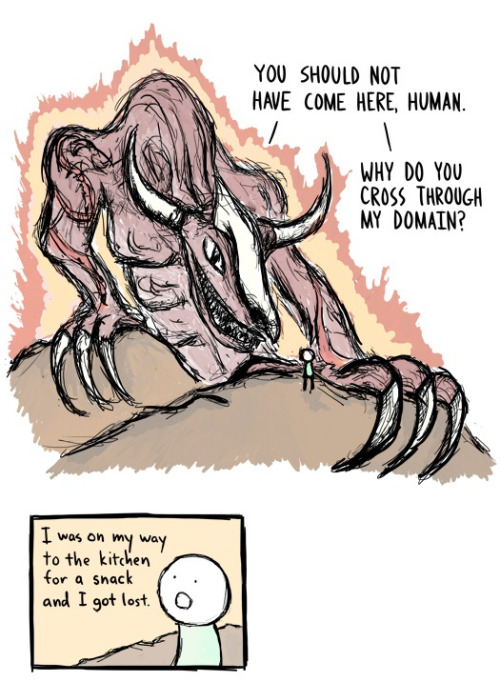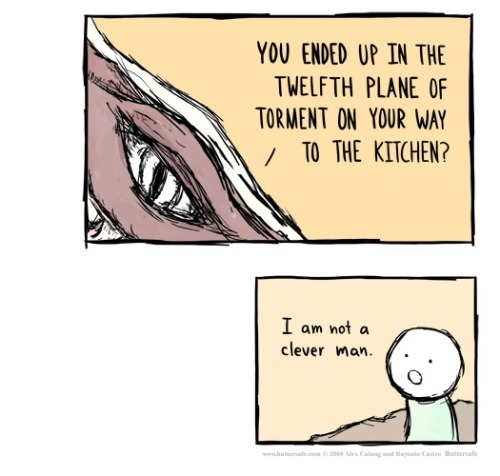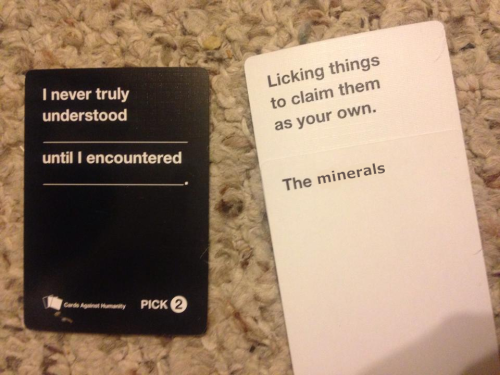Looking over the shoulders of Bob Lillie, OSU Emeritus Professor of Geology (Geophysics), and that of his wife, we get our first look into the deep cove behind North Falls. There's a distinct dark layer of sediment deposited between two massive flows of the Grande Ronde Basalt of the Columbia River Group. It forms the deepest recess here. Above that is a lighter band, which is also clearly sedimentary in origin, but appears to have been slightly to heavily contact metamorphosed as it gets closer to the contact with the overlying basalt. This explains the ramping outward from the dark strata: the rock is getting progressively tougher upward toward the contact. What's difficult to grasp in this photo, though, is a sense of scale. Looking carefully at the full-size version, I don't spot any people in this shot, but we'll have some in days to come.
Photo unmodified. August 30, 2012. FlashEarth Location (approximate).
Miscellaneous thoughts on politics, people, math, science and other cool (if sometimes frustrating) stuff from somewhere near my favorite coffee shop.
Saturday, January 10, 2015
Friday, January 9, 2015
Geo 1095: January 9, Day 739: North Falls Descent
The trail down to North Falls heads from the parking area a good ways to the west, then switches back to east and under the ledge we see in the photo. Judging from the height above the cove at this vantage point, I'm guessing I took this shot on the westward leg. According to this site, North Falls has a drop of 136 feet, which is not particularly high for a PNW waterfall. However, as that site notes, it's a very dramatic waterfall, and as we'll see soon, there's some very neat geology exposed in the cove.
Photo unmodified. August 30, 2012. FlashEarth Location (approximate).
Photo unmodified. August 30, 2012. FlashEarth Location (approximate).
Thursday, January 8, 2015
Geo 1095: January 8, Day 738: Middle North Falls
As I mentioned a couple days ago, the trail down to, and behind, Middle North Silver Falls was closed due to ice and snow. But Dana and I did have a nice view of it from a pull-out along the rim road. It was really gushing on this wet March day, and you can tell it's a much taller plummet than Upper North Falls. Unfortunately, we couldn't get at the excellent geology there; fortunately, I made it back in August.
Photo unmodified. March 10, 2012. FlashEarth Location (approximate).
Photo unmodified. March 10, 2012. FlashEarth Location (approximate).
Wednesday, January 7, 2015
Geo 1095: January 7, Day 737: Creepy Tree
I've heard a number of colloquialisms for trees with bent stems like the one above, "pipe-stem tree" is one of the more recent, and "dog-legged tree" is the term I first learned. But what they tell you is the same, regardless of what you call the trees themselves: the soil on this slope is slowly creeping downhill. The tree's roots tunnel deep into the ground, but the top few inches of soil slowly push down the slope (I'm guessing at generally slow rates, in the neighborhood of mm to cm/year.), and slowly push the tree over. But most plants have a geotropic response, and react by delivering growth hormones to the side that's relatively "down." So that side grows a little faster than the side that's "up," which has the net effect of straightening the plant out, to closer approximate vertical. I have been under the impression that with woody trees, once the stem has reached a certain maturity, it no longer grows upward, only outward. You can see a couple of sharper kinks in this Douglas fir trunk, one near the ground, and another about 2/3 of the way to the top of the photo. Above the latter, the stem looks much closer to vertical, though not quite there. This may represent episodic tilting. Or not. I'm not sure. But it definitely indicates soil creep.
Photo unmodified. March 10, 2012. FlashEarth Location (approximate).
Photo unmodified. March 10, 2012. FlashEarth Location (approximate).
Geo 365/730/1095: Mapping ALL The Geo!
As a reminder, this series was and is not intended to be devoted specifically to Oregon geology- though goodness knows, I've barely scratched the surface here. The focus on Oregon simply reflects the fact that I've spent very little time out of the state since I acquired a digital camera. In Dana's and my geogalvanting over the last four years and a few months, we've just skimmed into northwestern-most California one day, and northwest-most Nevada on another. But we're making planz... heh, heh, heh!
Geo 1095: January 6, Day 736: Upper North Silver Falls Again
This (and the previous) shot is from Dana's and my visit to Silver Falls in March of 2012. Not only was it raining pretty hard during much of our visit, but there was snow on the ground, and enough ice that the trail down to Middle North Falls was deemed unsafe and closed. That was disappointing, but the high water flows made the falls we could visit quite spectacular.
Another selling point for this particular waterfall is that it's one of the least physically demanding to get at. The path is mostly level, though rugged in places, and there's very little net elevation change from the parking area to the base of the falls. It's a bit less than a half mile one way.
Photo unmodified. March 10, 2012. FlashEarth Location (approximate).
Another selling point for this particular waterfall is that it's one of the least physically demanding to get at. The path is mostly level, though rugged in places, and there's very little net elevation change from the parking area to the base of the falls. It's a bit less than a half mile one way.
Photo unmodified. March 10, 2012. FlashEarth Location (approximate).
Monday, January 5, 2015
Geo 1095: January 5, Day 735: Upper North Silver Falls
I've been to Silver Falls, Oregon's largest State Park several times since I started blogging and acquired a digital camera. I've posted a few photos from there, but not in the context of this series. Time to remedy that. This is Upper North Falls, which may lead you to infer (correctly) that there is also a Lower North Falls. It might not lead you to infer there is also a Middle North Falls. The latter is, by a long shot, my favorite geological exposure in the park. However, this one is less showy, and less visited, and gives a better sense of solitude and intimacy. I'll get deeper into the geologic setting later, but the bedrock we see here is Columbia River Basalt, in the Grande Ronde Group (PDF).
Photo unmodified. March 10, 2012. FlashEarth Location (approximate).
Photo unmodified. March 10, 2012. FlashEarth Location (approximate).
Sunday, January 4, 2015
Geo 1095: January 4, Day 734: Boring Oregon City
The final shot of October 10, 2012, was somewhat disappointing, but still enough fun to post. I've been seeing photos of road signs labeled "Boring Oregon City" for years, but had never had a chance to shoot my own. In this drive-by, I was hurriedly trying to drag my camera out of its case as we approached; I had already put it away. Once I got it out, I had only a second or two to point and shoot, with no possibility of a second chance. Annnd... I cut it off. Oh well, still funny. And it's the type locality of the Boring Lava Field, so it's not entirely geologically irrelevant. It actually brings us nearly full circle, back to early in the day. Callan Bently has a post on a field trip through this unit. In the meantime, here's a somewhat more successful shot (from here):
(To be clear, "Boring" and "Oregon City" are two different communities.)
Photo unmodified. October 10, 2012. FlashEarth Location.
(To be clear, "Boring" and "Oregon City" are two different communities.)
Photo unmodified. October 10, 2012. FlashEarth Location.
Sunday Funnies: Warning Lights Edition
Keet Collie
Fake Science
Holiday leftovers. Cheezburger
Happle Tea
Noise to Signal
"Yet another unrealistic standard for girls..." Sober in a Nightclub
Sober in a Nightclub
What Would Jack Do?
SMBC
itrevormoore
Bif was NOT happy with the New Year's fireworks. Not as bad as July 4, but hid for quite some time. Cat Vs. Human
Channel Ate
Doghouse Diaries
Bizarro
Jim Benton
Sober in a Nightclub
Bad Newspaper
Funny to Me
Tastefully Offensive
"That's somehow even scarier than regular vampires." Senor Gif
Tom Toles
Sober in a Nightclub
Cheezburger
Very Demotivational
Bad Newspaper
Tastefully Offensive
Buttersafe
Tastefully Offensive
Fake Science
Very Demotivational
Deep Dark Fears
Cheezburger
Jim Benton
Geology is Hard
Fake Science
Holiday leftovers. Cheezburger
Happle Tea
Noise to Signal
"Yet another unrealistic standard for girls..." Sober in a Nightclub
Sober in a Nightclub
What Would Jack Do?
SMBC
itrevormoore
Bif was NOT happy with the New Year's fireworks. Not as bad as July 4, but hid for quite some time. Cat Vs. Human
Channel Ate
Doghouse Diaries
Bizarro
Jim Benton
Sober in a Nightclub
Bad Newspaper
Funny to Me
Tastefully Offensive
"That's somehow even scarier than regular vampires." Senor Gif
Tom Toles
Sober in a Nightclub
Cheezburger
Very Demotivational
Bad Newspaper
Tastefully Offensive
Buttersafe
Tastefully Offensive
Fake Science
Very Demotivational
Deep Dark Fears
Cheezburger
Jim Benton
Geology is Hard








































